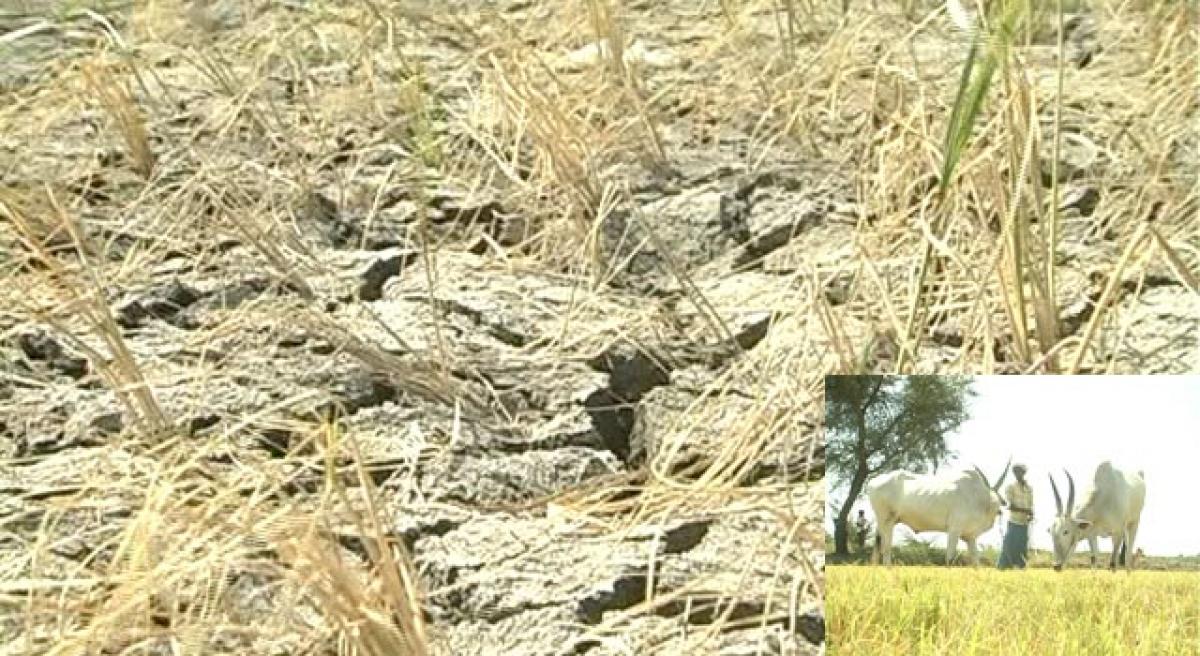Live
- 200 complaints received from various political parties: ECI
- Moto G64 5G Launched: Specifications, Features, and Price in India
- Paytm clarifies licensing process status amid speculations, says govt champions fintech
- Bramha Kumar appointed as India's next Ambassador to Zimbabwe
- A wellness journey in Azerbaijan’s great Caucasian Forest
- Boeing’s Starliner to fly 1st crewed mission to space on May 6
- Indians up their spending on dieticians by 125 pc in FY24: Report
- Tesla layoffs reminder of Twitter sackings, some departments lose 20 per cent staff
- Can Meditation and Mindfulness Help you Propel your Career?
- People in Karnataka won't tolerate ‘rowdyism’ in politics: Bommai
Just In

The location resembles fertile areas in Krishna and Godavari districts, but this time the Tungabhadra reservoir has water stored up to 50 per cent of its capacity due to failure of monsoon in Karnataka. Things have worsened in the tail end areas due to inadequate flow of water through the HLC main canal.
Bommanahal (Anantapur): More than 24,000 acres in Kanekal sub-division in Bommanahal mandal where paddy crop was being raised is on the verge of withering due to a steep decline in water release from the Tungabhadra Dam caused by failure of monsoon in Karnataka. Of the 36,000 acres of ayacut area in Kanekal sub-division one third of the area which is 12,000 acres had been kept idle without raising any crop by the farmers due to bleak prospects of crop survival. Normally, the ayacut area is fertile and farmers are raising paddy every year.
The location resembles fertile areas in Krishna and Godavari districts, but this time the Tungabhadra reservoir has water stored up to 50 per cent of its capacity due to failure of monsoon in Karnataka. Things have worsened in the tail end areas due to inadequate flow of water through the HLC main canal.
Water from Tungabhadra has not reached the tail end areas in the 10 Distributary Committee areas. Large tracts of crop lands could be seen either withered, or with stunted growth. If water supply is not ensured immediately crops would be totally withered. Farmers with whom The Hans India spoke, felt that Chief Minister Nara Chandrababu Naidu should negotiate with the Karnataka government and arrange for release of whatever available water in the Tungabhadra Dam.
Appa Rao, a farmer from Devagiri, bemoaned that his paddy and millets crop needed wetting twice for survival of the crop. He said that adding insult to injury, farmers from non-ayacut areas were using the water allotted to the ayacut farmers by illegally pumping water with pipes making things worse. As many as 1,000 such illegal pumps are in operation depriving the ayacut farmers of their allocated water.
Another Venkata Swamy of Hirehal mandal who spoke to this reporter said that under his distributory canal crops were raised only in 4,000 of the 8000 acres of ayacut due to water famine. His crop lands along with other co-farmers were given a single wetting and unless the stopped water supply is resumed, their crops would be wasted along with their investment on the crop. In Bommanahal crop is raised in 20,000 acres out of the original ayacut area of 35,000 acres.
Another farmer Mohan Babu of Harepuram in Bommanahal mandal says that he is raising paddy crop in 40 acres of lands and Mallikarjun another farmer in 10 acres of land. They complained that their paddy and maize crop has not witnessed growth due to insufficient water as the supply was stopped midway. Unless the government talks to the Karnataka government and ensures release of water for wetting their crops in the next 10 days, their hope of bumper harvest would be dashed.
Divisional engineer D V Rama Sanjanna told The Hans India at Kanekal that farmers faced such a precarious position twice in the past in 2002-03 and in 2015-16 when the water availability in Tungabhadra Dam had declined to 80 tmc and 76 tmc respectively due to erratic monsoon. The water flow into the dam this year was only up to 52.004 tmc as against its capacity of 100 tmc. This time only 12 tmc of water was made available, out of which 10 tmc water was for the drinking water requirements of Anantapur city.
He said that the farmers were cautioned against going for sowing without making an assessment of the situation caused by erratic monsoon and poor water levels in the Tungabhadra Dam. They were advised in advance against going for ambitious sowing, but many had not heeded the advice, he added.

© 2024 Hyderabad Media House Limited/The Hans India. All rights reserved. Powered by hocalwire.com







